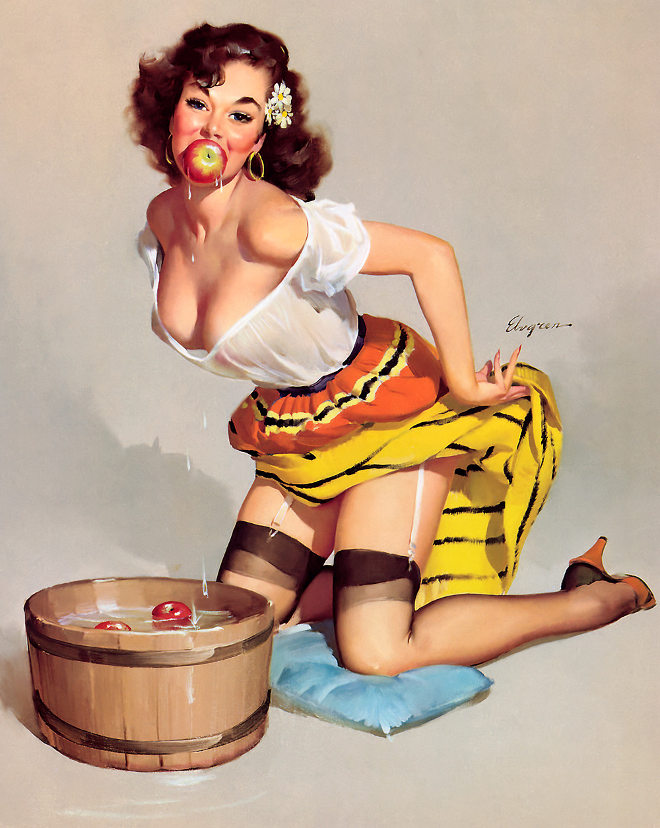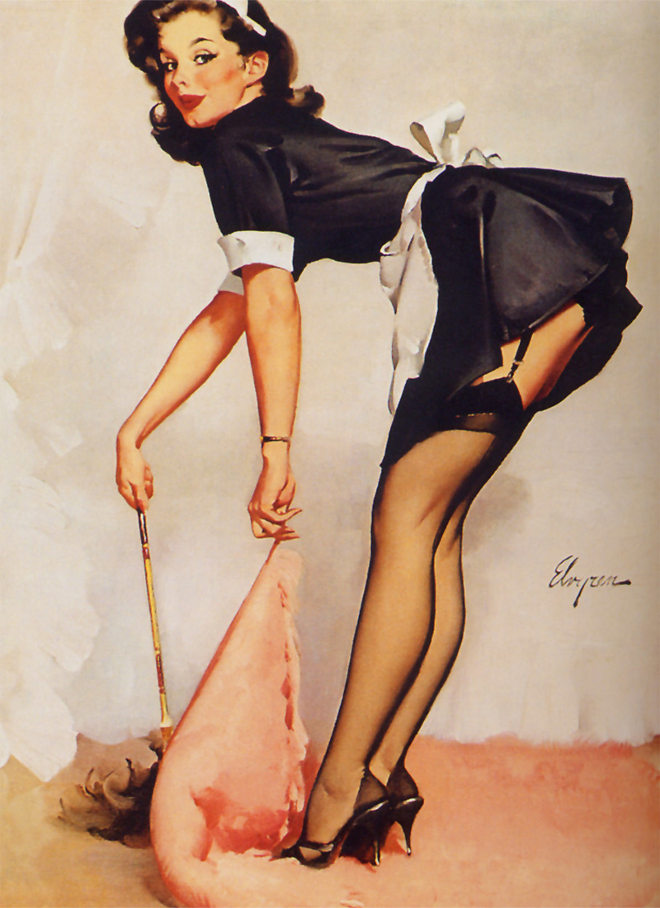Go Home, Retro, You’re Drunk: On Political Conservatism And Vintage Subcultures
The Miss Pinup Australia retro pageant celebrates the conservative gender values of a fantasised past. Why are we so drawn to the 1950s, for Bettie or for worse?

Over the weekend, I came across this article about the Miss Pinup Australia beauty pageant. Fairfax journalist Cindy Ngo interviewed the event’s founder, Miss Pixie, and two pageant participants: Miss Candy Floss and Miss Belles B Ringing.
I am familiar with this competition, as Nicole Jenkins of Circa Vintage is a regular judge and I read her account of the 2011 Hobart final. Nicole has also blogged some tips on how to dress in 1950s pinup style. Until I read the Fairfax article, I saw Miss Pinup Australia as an indulgent but essentially playful part of the commodified subcultural assemblage we can call ‘retro culture’.
The Consolations of Retro
In the past, I’ve distinguished between ‘vintage’ and ‘retro’. ‘Vintage’ is a retail fashion system trading in original garments from past eras; ‘retro’ is a lifestyle based on the aesthetic of a past era, and its accompanying feelings and cultural associations.
Although I personally don’t feel invested enough in retro to identify with it as a subculture, I have done a heap of research into retro scenes both here and internationally. I’ve followed blogs, Tumblrs and Pinterest boards, watched YouTube hair and makeup tutorials, visited vintage stores and retro fairs, spoken to entrepreneurs and aficionados, and researched the most popular cultural touchstones.
As a result, I have a working understanding of the way subcultural knowledge circulates within interest-based communities, and the small businesses that service them. Retro enthusiasts recognise one another as kindred spirits. They build their emotional knowledge along with their archival knowledge by paying for commodities and experiences: visiting vintage fairs, re-enactment events, conferences and fan conventions; taking high tea; socialising in tiki cocktail bars; going swing dancing; participating in pinup, burlesque and go-go classes; watching old movies.
The consolations of retro are that they help us feel more at home in our bodies. By surveying and rescuing centuries’ worth of outmoded styles, retro offers us a broader smorgasbord of sizes and fits than the industrial constraints of contemporary fashion can offer. Bombshell Vintage’s Kate Millett told me that the best thing her store offers shoppers is “the freedom to explore fashion without judgement, a place where they know they can find clothes that are gorgeous just for them!”
Retro styles also allow us to project ourselves into the magical spaces of pop culture by dressing like our period heroes, from Fitzwilliam Darcy to Alain Delon, Hunter S Thompson to Nucky Thompson. Along with the clothes, we try on the glamour of the screen and the powerful emotions conjured by fiction.
But for me, Miss Pinup Australia offers a cautionary tale about the dangers of getting drunk on history. We are inescapably creatures of our present, and even our most meticulous attempts to conjure the past can only ever be incomplete and temporary. But our temporal distance offers us the perspective to ask ourselves why particular eras appeal to us. When we name our desires, we come a little closer to understanding how to be content with our bodies and lives.
The Politics of Pinup Culture
My personal belief is that most contemporary celebrations of the pinup aesthetic are not very thoughtful. They reproduce older forms of women’s sexual exploitation with a tasteful veneer of retro kitsch. Madeleine Hamilton’s book, Our Girls: Aussie Pinups of the 40s and 50s, offers a nuanced view of what pinup imagery meant for the models and the men who consumed their images, but many contemporary celebrations of pinup imagery are seemingly only interested in re-enacting its visual language of outfits, poses and facial expressions. Reading this as ’empowering’ for women of all ages and body shapes is only possible because of our temporal distance.
“A woman is a present,” opines Miss Pixie in the Fairfax article. “If you wrap the present and allow a man to use their imagination, then you’ll find that you’ll get the respect that you deserve.”
My reaction to that nugget was, oh wow. It couldn’t be further from my own politics. The event’s ‘About’ page makes her conservative approach to gender even more explicit:
“Miss Pixie, founder of Miss Pinup Australia has lived in a time warp, so to speak for the last 30 years. She has reverted back to the 1950’s [sic], an era that she believes portrayed women at their finest with magnificent hairstyles, flawless makeup, clothing that was flattering to any body shape & age and more importantly some good old fashioned values. This was an era when women had self respect.”
She’s very much like the Time Warp Wives I wrote about in Out of Shape.
Many of these women wholeheartedly adopt the meticulously period-perfect trappings of a chosen era because they feel at odds with contemporary values, as well as contemporary clothes. They cherish traditional gender roles, deplore today’s lack of civility and respect, take pride in being ignorant of current affairs, and see their museum-worthy homes as refuges from a hostile outside world.
Miss Pixie is entitled to see the world through whatever prism she chooses. But I find it troubling that she is aestheticising and commodifying her conservatism. She is presenting it as beautiful, aspirational and empowering, when it is structured to reflect her politics, and is really about making money.
I have no problem with an entry fee — you have to cover your costs, after all — but to even participate in the pageant you have to attend a three-hour deportment class run by Miss Pixie’s company (costing $170), and you have to supply professional headshots taken by photographers affiliated with Miss Pixie. “Any photos that are submitted that are not of a vintage pinup style will not be accepted,” she writes. And who’s the judge of that correct style? She is!
Why Are Retro Fans So Into The 1950s?
The whole thing highlights the complex and contradictory ideas we have about “the 1950s”. Back in 2010, I wrote an essay for Crikey about the politics of nostalgia:
The fifties are often publicly invoked as a totem of all that is small-minded, conservative and repressive. When governments refuse to engage with socially progressive ideals such as abortion and gay marriage, they’re routinely accused of nostalgic impulses: wanting to turn back the clock on social policy.
But demonising the past always serves the ideologies of the present. From juvie-hall B-movies to novels about junkies, fifties culture displayed a strongly nihilistic streak. Norman Mailer’s 1957 essay ‘The White Negro’ located this discontent in the still-recent horrors of WWII. People’s trust in traditional morality and authority was shaken, along with their faith that their lives mattered.
Ironically, the mid-century cultural touchstones that are now celebrated nostalgically were intended to critique and confront. Grace Metalious’s Peyton Place (1956) unmasked small-town hypocrisy; Christopher Isherwood’s A Single Man (1964) mined the loneliness of the closet; in Portnoy’s Complaint (1969), Philip Roth turned an excoriatingly hilarious eye on Jewish self-loathing. Frank O’Hara’s poetry and John Cheever’s fiction captured, in Natasha Vargas-Cooper’s lovely phrase, “the sensation of an atomised heart pounding furiously in a dissolving world”.
I do wish there was more introspection in the public sphere about why we specifically focus both our ire and our desire on this decade, when conservatism still flourished before and after the 1950s.
But women retro enthusiasts are not idiots. They have grappled with the question of whether it’s a feminist act to wear clothing from eras when women were disenfranchised and confined to the domestic sphere. “I’m misread as conservative, as people mistake my aesthetic nostalgia for a moral nostalgia,” writes Michelle Garrett at her blog, Ravishing Retro.
And at The Social Life of Second-hand Clothes, sociologist Nancy Fisher writes that she uses vintage style as “a sort of camouflage, or rather a mediator, that softens and eases social relations … I am far too direct and blunt for Minnesota Nice sensibilities, and I sometimes put on a delicate embroidered 1950s cardigan or a flowery print to soften the messenger, since I can’t seem to master softening the message.”
Lena Weber, a German-born ’60s enthusiast and editor of The Vintage Guide to London, believes retro scenesters have such a diverse range of ages and body shapes because they shop for clothing by fit, not by size. When Lena tries on a vintage dress that doesn’t fit, “it doesn’t give me that feeling of horror when I couldn’t fit into my size on the highstreet, where it felt like every too-small dress was the entire clothing industry laughing at my failure to be a size ten with perfect breasts.”
Retro fans are pragmatists, agrees Gemma Seager, alias Retro Chick. “We pick and choose our role models, not looking to return to a previous time in history, but take those bits from it that we feel appeal to us, suit our bodies and our lifestyles.” Recognising size evolution, they’ll buy a reproduction 1940s dress, “rather than cursing their modern, well nourished bodies for not fitting into a dress designed for a body bred on rationing.”
Writing at Utne Reader, Katie Haegele argues that wearing old clothes is a postmodern strategy of female solidarity that “has allowed me to piece myself together into some version of today’s woman, which is a person who surely couldn’t exist without the women who went before her and is in some sense a pastiche of them all.”
She also cites a zine called I Love Vintage (but I wouldn’t want to live there), in which the zinester Holli Mintzer explains that she wears old clothes “Because I want to reclaim vintage styles without their racist, sexist, homophobic, patriarchal bullshit baggage.”
Many retro fans insist that its strength is in refusing fashion’s conformist – and often misogynist – ethos. “I believe that many, if not all, women who adopt a vintage look do so because they want to,” writes UK vintage blogger Lori Smith. “After all, wearing a demure 1950s prom dress could make you look like a doormat of a woman, but only if you behave like one too.”
–
Mel Campbell is a freelance journalist and cultural critic. She is the author of Out of Shape: Debunking Myths about Fashion and Fit, blogs about style, history and culture at Footpath Zeitgeist, and tweets at @incrediblemelk.
Feature illustration by Gil Elvgren

